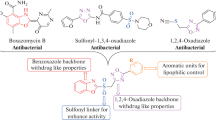Microorganisms in the biofilm structure cause severe health problems and economic losses. Therefore, it is very important to design and screen anti-biofilm molecules that can solve the related problems. This paper is aimed to demonstrate the antimicrobial and anti-biofilm properties of allyl substituted benzimidazolium-based Ag(I)-containing N-heterocyclic carbene (NHC) complexes. In this work, the antimicrobial and anti-biofilm properties of six allyl-substituted benzimidazolium-based Ag(I)-NHC complexes, the synthesis and characterization of which had been carried out previously, were investigated. The antibacterial properties of Ag(I)-NHC complexes were tested by the broth microdilution method. The biofilm formation was detected by microtiter plate assay. All test compounds (1–6) showed strong and same activity against Escherichia coli ATCC 25922 at concentrations of ≤3.9 μg/mL as compared to that of the reference anti-biotics (ampicillin). Test compounds exhibited the same or stronger activity than the reference drug against the Acinetobacter baumannii isolate with MedIC values of 15.6 – 31.25 μg/mL in comparison to the positive control colistin. All compounds inhibited the formation of E. coli biofilms at sub-MIC concentrations by 56 – 90%. Furthermore, it was found that these compounds reduced Klebsiella pneumoniae biofilm formation by 29 – 65%, S. aureus biofilm formation by 36 – 52%, E. faecalis biofilm formation by 38 – 50%, A. baumannii biofilm formation by 51 – 60%, and Candida albicans biofilm formation by 38 – 53%. Regarding the biofilms formed, it was established that the test compounds eradicated the mature of E. coli biofilm by 43 – 63%, K. pneumoniae biofilm by 16 – 40%, S. aureus biofilm by 18 – 39%, E. faecalis biofilm by 15 – 27%, A. baumannii biofilm by 27 – 53%, and C. albicans biofilm by 18 – 41%. Compounds evaluated in our work, which is one of the few studies on benzimidazolium-derived NHCs, have the potential to become new biological agents with strong antimicrobial properties and activity against microbial biofilms. Therefore, further in vivo and in vitro studies should be conducted.

Similar content being viewed by others
References
C. Dumitru, Rev. Rom. Med. Vet., 28, 35 – 40 (2018).
H. C. Flemming, J. Wingender, U. Szewzyk, et al., Nat. Rev. Microbiol., 14, 563 – 575 (2016).
M. Alsan and M. Klompas, J. Clin. Outcomes Manag., 17, 363 – 369 (2010).
R. Roy, M. Tiwari, G. Donelli, and V. Tiwari, Virulence, 9, 522 – 554 (2018).
İ. Özdemir, O. Çiftçi, E. Evren, et al., Inorg. Chim. Acta, 506, 119530 (2020).
E. Üstün, M. S. Çelebi, M. Ç. Ayvaz, and N. Şahin, Z. Naturforsch. C., 76, 219 – 227 (2021).
S. D. Düşünceli, D. Ayaz, E. Üstün, et al., J. Coord. Chem., 73(13), 1967 – 1986 (2020).
T. Bernardi, S. Badel, P. Mayer, et al., ChemMedChem, 9, 1140 – 1144 (2014).
H. Jacobsen, A. Correa, A. Poater, et al., Coord. Chem. Rev., 253, 687 – 703 (2009).
R. A. Haque, M. A. Iqbal, F. Mohamad, and M. R. Razali, J. Mol. Struct. 1155, 362 – 370 (2018).
S. Patil, J. Claffey, A. Deally, et al., Eur. J. Inorg. Chem., 2010(7), 1020 – 1031 (2010).
A. Kascatan-Nebioglu, M. J. Panzner, C. A. Tessier, et al., Coord. Chem. Rev., 251(5–6), 884 – 895 (2007).
M. J. Panzner, A. Deeraksa, A. Smith, et al., Eur. J. Inorg. Chem., 2009(13), 1739 – 1745 (2009).
G. Roymahapatra, S. M. Mandal, F. W. Porto, et al., Curr. Med. Chem., 19(24), 4184 – 4193 (2012).
E. Çevik-Yıldız, N. Şahin and S. Şahin-Bölükbaşı, J. Mol. Struct, 1199, 126987 (2020).
S. Şahin-Bölükbaşı, N. Şahin, M. N. Tahir, et al., Inorg. Chim. Acta, 486, 711 – 718 (2019).
N. Şahin, S. Şahin-Bölükbaşı,M. N. Tahir, et al., J. Mol. Struct., 1179, 92 – 99 (2019).
E. Üstün and N. Şahin, J. Indian Chem. Soc., 97, 1 – 5 (2020).
H. Gezegen, C. Hepokur, U. Tutar, and M. Ceylan, Chem. Biodivers., 14, e1700223 (2017).
U. Tutar, Fresenius Environ. Bull., 27, 3713 – 3720 (2018).
U. Tutar, C. Celik, İ. Karaman, et al., Trop. J. Pharm. Res., 15,1039 – 1046 (2016).
N. B. Hallam, J. R. West, C. F. Forster, and J. Simms, Water Res., 35, 4063 – 4071(2001).
J. L. Del Pozo, Expert. Rev. Anti. Infect. Ther., 16, 51 – 65 (2018).
G. D. Wright, Nat. Prod. Rep., 34, 694 – 701 (2017).
C. H. Chen and T. K. Lu, Antibiotics (Basel), 9, 24 (2020).
S. Nayak and S. L. Gaonkar, ChemMedChem, 16, 1 – 32 (2021).
A. G. B. Dileepan, A. Ganesh Kumar, R. Mathumidha, et al., Chem. Pap., 72, 3017 – 3031 (2018).
G. Achar, P. P. Hokrani, K. N. Brinda, et al., J. Mol. Struct., 1196, 627 – 636 (2019).
C. R. Shahini, G. Achar, S. Budagumpi, et al., J. Organomet. Chem., 868, 1 – 13 (2018).
İ. Özdemir, S. Demir, S. Günal, et al., Inorg. Chim. Acta, 363, 3803 – 3808 (2010).
Y. Gök, S. Akkoç, H. Erdoğan, and S. Albayrak, J. Enzyme Inhib. Med. Chem., 31, 1322 – 1327 (2016).
N. Kaloğlu, M. Kaloğlu, İ. Özdemir, et al., J. Chin. Chem. Soc., 64, 420–426 (2017).
C. R. Elie, G. David and A. R. Schmitzer, J. Med. Chem., 58, 2358 – 2366 (2015).
T. Samanta, G. Roymahapatra, W. F. Porto, et al., PLoS One, 8, e58346 (2013).
J. Tessier and A. R. Schmitzer, RSC Adv. 10, 9420 – 9430 (2020).
Acknowledgments
The authors would like to thank the Sivas Cumhuriyet University, Faculty of Medicine (CUTFAM) Research Center for technical support.
Conflict of Interest
The authors declare that they have no conflicts of interest.
Author information
Authors and Affiliations
Corresponding author
Rights and permissions
About this article
Cite this article
Tutar, U., Çelik, C. & Şahin, N. Allyl Functionalized Benzimidazolium-Derived Ag(I)-N-Heterocyclic Carbene Complexes: Anti-Biofilm and Antimicrobial Properties. Pharm Chem J 56, 54–60 (2022). https://doi.org/10.1007/s11094-022-02601-6
Received:
Published:
Issue Date:
DOI: https://doi.org/10.1007/s11094-022-02601-6




